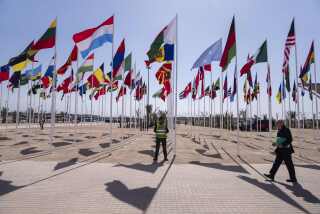Behind the jargon at the IMF

- Share via
Given the chance to be a fly on the wall at any institution, few would choose the International Monetary Fund.
As part of a series from the Writers in Residence nonprofit organization, novelist Geoff Dyer spent a fortnight on a U.S. aircraft carrier, the George HW Bush. Douglas Coupland, a Canadian writer, chose Alcatel-Lucent, the French telecom company.
With the IMF as his subject, author Liaquat Ahamed seems to have opted for a palette of grays — although that is not how he sees it.
For Ahamed, best known for “Lords of Finance,” his 2010 Pulitzer-winning book about the 1930s financial crisis, the IMF conjures romantic memories.
It was there that he met his wife, Meena, more than 30 years ago. (Full disclosure: I know the author.) “I hold an unusually sentimental attachment to the Fund,” he writes, “an institution more often associated with number crunching and debt than with true love.”
Thankfully, he now removes his rose-colored spectacles for “Money and Tough Love: On Tour With the IMF,” a book published by Visual Editions.
The result is a refreshingly non-jargonized observation of an enormously powerful institution that very few understand. Posing as the lay reader’s ally, even Ahamed pretends not to fathom the IMF — although we know that he does really. How else could you fall in love there?
Even the organization’s own staff members at times struggle to spell out how it works.
“The Fund’s finances are unusually arcane, involving a complicated system of book entry credits and debits in many different currencies — some of which can be readily used, others not — between the balance sheet of the organization itself and the central banks of the world,” Ahamed writes. “I find that even people who work there are hard-pressed to explain the accounts.”
Mercifully, the author’s aim is not to audit the IMF. This is a book about the troops, not the generals. As such, Christine Lagarde, its French managing director, merits only a cameo role.
Ahamed offers an impression of how the IMF works from day to day, rather than a “tick-tock” account of its most dramatic moments. Nor is it a history; Ahamed avoids the leaden prose of an in-house biographer.
Yet somewhere on his itinerary, which takes in the fund’s annual meetings in Tokyo in 2012, a “battlefield triage” mission to Ireland and a stopover in Mozambique, he finds an institution much softened from what it once was.
The fund used to be seen as the world’s leading financial sadist — or a “grandmotherly” scold, in the quainter phrase of John Maynard Keynes, who conceived and co-founded it in the 1940s.
During the 1970s and 1980s its chief role was to stabilize flailing currencies by imposing harsh austerity on its “clients.” Nowadays it is often found arguing against too much austerity, whether it is taking on the Germans, the European Central Bank or gold standard devotees.
The fund has also diluted its orthodoxy against capital controls. It even seems to disapprove of too much inequality.
“I took comfort in the notion that the organization had the internal dexterity to … draw lessons from its errors,” Ahamed writes. “By contrast, the Germans appear to be totally without doubt. So convinced did they seem of their rectitude, that they came across as rigid and dogmatic — dare I say it, Germanic.”
Not so long ago a visiting IMF mission of “hard-faced men with red pencils” would trigger demonstrations. Nowadays, they are sometimes welcomed.
In Dublin, Ahamed found 20,000 farmers on the march against a cut in their EU quotas, but not a peep against the “geeks” arriving to help put Dublin’s finances in order.
In Maputo, the capital of Mozambique, a city often beset by violent protests, the fund team camped out in a bungalow with a corrugated iron roof. “It was like finding your Wall Street banker uncle living in a Bohemian shack on Key West,” Ahamed writes. One of the team’s roles was to help persuade Mozambique to build a social safety net.
The fund no longer has a monopoly on what to administer to its patients.
In Europe, it locks antlers with the European Central Bank. Elsewhere it may have to contend with the Brics development bank that was launched in Brazil this month.
Perhaps competition explains the IMF’s apparent retreat from dogma. Or perhaps the nature of the disease has changed. Whatever the reason, Ahamed brings life to an institution that is too often deadened with jargon.
Edward Luce is the chief U.S. commentator for the Financial Times of London, in which the review first appeared.
More to Read
Inside the business of entertainment
The Wide Shot brings you news, analysis and insights on everything from streaming wars to production — and what it all means for the future.
You may occasionally receive promotional content from the Los Angeles Times.










